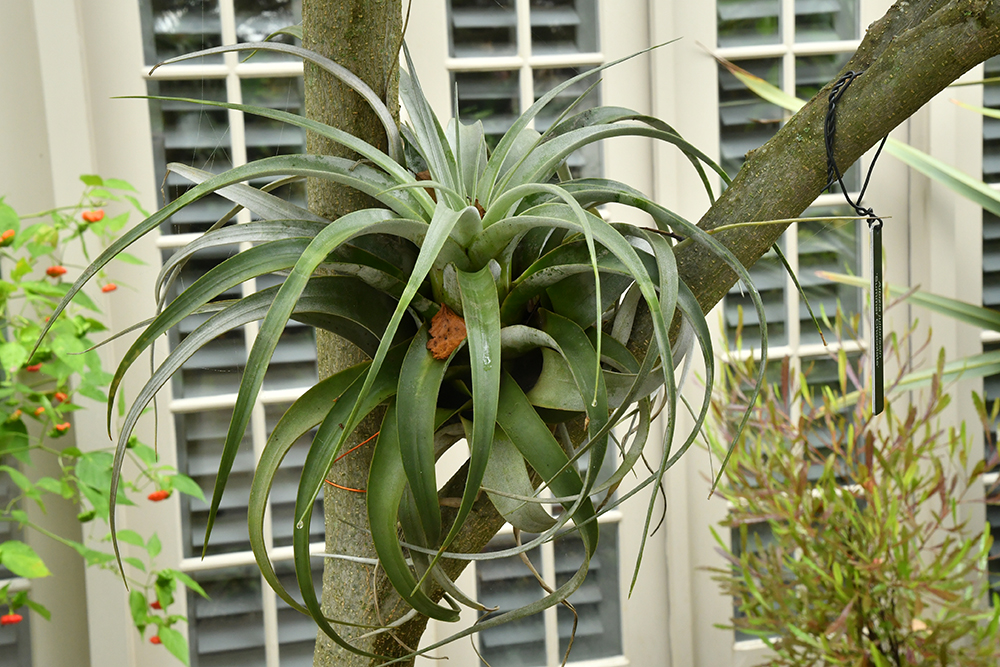It is no secret that plants, much like clothing go through trends. In fact, plants that are popular during one decade may not even be seen at nurseries during the decades to follow. Air Plants, botanically known as Tillandsia were a mere curiosity 10 years ago, and now are a 'houseplant' of great demand. Its interest lies in the plants' mysterious ability to seemingly live on air without any soil nor obvious root system. Of course, it does not really live on air, so what is the mysterious story behind the life of this plant that has captured the curiosity of so many?
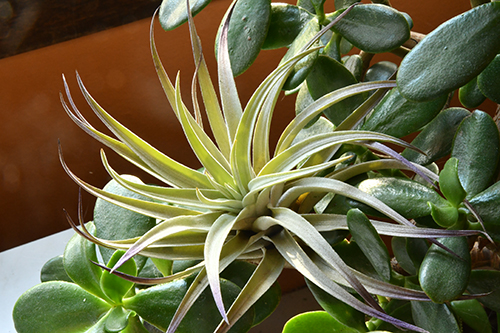
Tillandsia is in fact a member of the Bromeliad family or Bromeliaceae and includes close to 650 species. It is found within a subfamily called the Tillandsioideae that contains an additional eight genera. It is native to mountains and deserts extending from Argentina, north through Mexico into SE North America and the Caribbean. The genus was named in 1753 by the Swedish botanist Carl Linnaeus (1707–1778) after the Finnish physician and botanist Dr. Elias Tillandz (1640–1693). Tillandz published one the country's first botanical writings in 1673, the Catalogus Plantarum and provided treatments for his patients based upon his knowledge of plants. Although quite variable, most Air Plants consist of small rosettes of foliage, such as Tillandsia harrisii (Picture 1). They measure from a few inches to nearly a foot in diameter with possibly a few roots at the base intended only for anchoring the plant. Without the need for any soil, they are amazingly light and look great in hanging glass spheres, perched on gravel or sitting in other house plants, such as in the Jade Plant (Crassula ovata) (Picture 1). Interestingly, the story of this genus began with a large scale geologic occurrence that actually shifted the Amazon River from flowing into the Pacific and into the Atlantic Ocean!
The first Bromeliads are thought to have developed around 100 to 80 million years ago (MYA) on very nutrient poor soils in the Guiana Highlands of what is now Southern Venezuela and Guyana. The Guiana Highlands are geologically called a craton. A craton is a stable and internal portion of a tectonic plate that remains relatively undisturbed through the movement of the plates. Oddly, by 20 MYA, only a few species existed, indicating the nutrient poor soils provided little impetus for speciation. The impetus for speciation was soon to come and was tied to the development or 'orogeny', as it is called in geological terms, of the Andes Mountains.
The Andes began to rise around 30 MYA, but their ascent was not the smooth and consistent rise one may typically envision with the rise of mountains. Mountains form when one of earth's tectonic plates slowly moves below an adjacent plate, a process known as subduction. The action of the subducting plate moving against the upper plate causes the upper plate to 'wrinkle', slowly leading to mountain development. During the development of the Andes, it is believed a portion of the sinking plate slowly developed a large bulge along its base that ran along the entire length of the uplifting mountain range. When the bulge finally sheared off and dropped into the molten mantle below, it allowed the subducting plate to buoy upwards, causing a rapid uplift. This process happened twice, with the first uplift between 22–17 MYA and the second 10–5 MYA. Although several million years may not seem rapid, in geologic terms, it is an overnight occurrence! Accompanying the rise of the Andes was the creation of numerous new environments, ripe for the speciation of Bromeliads and the birth of the epiphytic genus Tillandsia around 15 MYA.
An epiphytic 'life-style' is nothing new to members of Bromeliaceae, since this life style shift is believed to have developed on three different occurrences. An epiphytic plant is one that lives high in the canopy of a tree or cactus, or in some cases they become lithophytic, whereby the attach to rocky outcrops and cliffs high above the ground below. An epiphytic plant is not parasitic, whereby the plant extracts nutrients from the host plant. Rather, it uses the host merely for support and the roots serve as a mechanism of attachment, not for gathering nutrients or water. The environmental pressure for an elevated habitat has several advantages: it eliminates the competition for water and nutrients on the forest floor; it provides a brighter or sunnier location within the dense forest, enhancing the plants photosynthetic capabilities; and it allows the flowers to be more easily seen and approached by pollinators.
Without true roots anchored in soil, the challenge for these arboreal and cliff dwellers focused on an alternative manner for securing a source of water and nutrients. For members of the bromeliad family, the answer lied in the development of specialized scale-like structures called trichomes that cover the leaves. Gardeners usually associate trichomes with pubescent or fuzzy leaves, much like that of Lamb's Ears (Stachys byzantina) or the undersides of a Yak Rhododendron (Rhododendron yakushimanum). The function of the trichomes in these cases is to prevent desiccation from the drying effects of persistent winds. However, there are other types of trichomes with different shapes and function. For example, in Stinging Nettle (Urtica dioica) the hollow trichomes act to inject histamine and other pain inflicting chemicals into grazing or otherwise life-disturbing animals as a defense mechanism. For members of the Bromeliad family, the function of the trichome is to absorb nutrients and water! However, the story of their development doesn't end there.
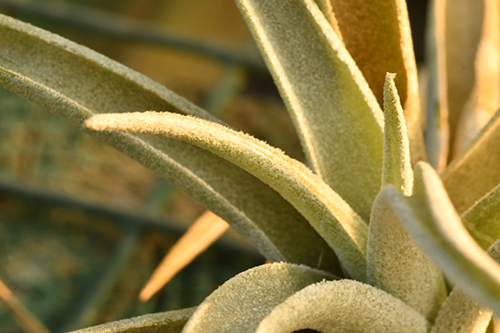
As the Andes continued their ascent and Panama rose, connecting North and South America some Tillandsia species moved northwards into Mexico and southern reaches of North America and adapted to a hot, dry and xeric environment. These species developed a more open or sprawling habit with a far greater number of trichomes, giving the plants a dusty white and fuzzy appearance to the leaf, as seen in Picture 2. These plants often, yet not always have far narrower leaves. Other species remained in the moister and more humid mesic locations. The leaves of mesic dwellers are more upright in orientation and are distinctly greener due to fewer trichomes.
For xeric Air Plants, like Tillandsia tectorum (see below), the additional trichomes not only aid in collecting moisture, but the silvery coating helps to reflect sunlight and keep the leaf cooler. It also helps to hold a layer of air close to the leaf, protecting the plant during the cold, desert or high elevation nights. Even the more open leaf habit aides the plant in this drier environment, as it will allow more dew to collect on the leaves for ultimate absorption via the trichomes. Ingenious! Some of the xeric species are also aerophytes rather than epiphytes. An aerophyte is located close to or on top of the ground and with few anchoring roots, they often drift about on sand dunes. By comparison, the more upright form of mesic plants indicates how the more humid environments preclude the need to collect the moisture of dew on the leaves. They also have fewer trichomes, translating into a greener appearance.
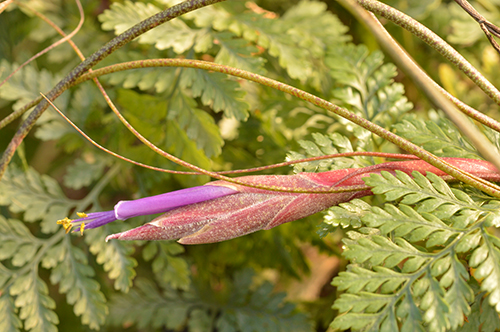
Trichomes are obviously the key to the survival of Air Plants. When viewed under a microscope, leaves of plants in xeric regions have a peltate or shield-shaped trichome while trichomes in mesic areas loosely resemble an inverted Sea Anemone. Trichomes consist of an outer ring of dead wing cells that surround a central column of living cells called a stalk. Although dead, the wing cells consist of very flexible cellulose and move in response to moisture. The stalk cells penetrate through the leaf epidermis or outer covering and provide a point of entrance for the water. When the leaf is moist, the wing cells lay flat on the leaf and the central cells of the stalk rise slightly, allowing water to pass into the leaf through osmosis. The action of the wing cells lying flat on the leaf allows the water to more easily move towards the stalk via capillary action. When dry, the wing cells stand upright, and the cells in the stalk lower, creating a plug. Combined with a process that prevents reverse osmosis, water cannot pass out of the leaf. Have I mentioned amazing! It is the upright wing cells that provides the silvery and somewhat pubescent appearance to the leaf for the xeric species. In order for plants to further reduce water loss, they incorporate CAM photosynthesis. This process allows the stomates to only open at night when temperatures are lower, reducing water loss during the day. The function of the stomates is to allow 'air' with CO2 into the leaf, such that photosynthesis and the production of carbohydrates can occur while they also allow O2 with some moisture to pass out of the leaf. This explains the slow growth of Air Plants, since only a limited amount of carbohydrates are produced daily from the equally limited CO2 supply, but it ensures life in dry environments.
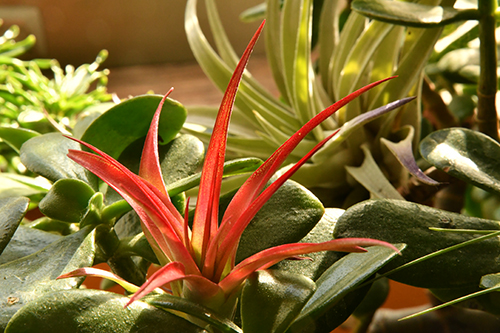
Air Plants also have striking flowers! The 3-petaled flowers are typically a very colorful red, yellow or bright cyan blue in color, emerging from red or yellow protective bracts. The individual flowers can be tubular, as produced by T. butzii as seen in Picture 3 or the tips of the petals can be reflexed back. Flowers can appear on very simple stems that develop and produce flowers within a few weeks or on a significant and well-branched inflorescence that takes several months to develop before flowers appear. Each individual flower usually lasts 5–7 days. The stamens release pollen at the start of bloom, followed by the stigma becoming receptive to pollen during the end of bloom, preventing self-pollination. For some species, such as Tillandsia brachycaulos var. abdita (Picture 4), the foliage turns red prior to and during bloom to enhance the display! The brightly colored flowers attract moths, hummingbirds, ants and even bats! Interestingly, Hummingbird speciation began simultaneously in South America around 22 MYA as the Andes started to rise and dramatically grew from 10–6 MYA, during the second lift.
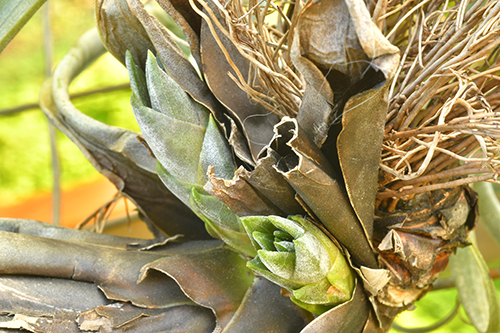
Nothing happens in a vacuum and the expansion of Tillandsia species coincided with and supported the expansion of the pollinating Hummingbirds! As the seeds mature, they develop a pappus or parachute-like structure, much like a dandelion that floats to the next supporting branch, trunk, or cliff. After flowering, the plant produces one to several small plants or pups at the base while the mother plant slowly withers and dies. Two emerging pups are seen in Picture 5. When the pups are roughly 1/3 the size of the original mother plant, they can be pulled apart into separate plants or preferably left to form an ever growing cluster.
Care of Air Plants is based upon whether they are Xeric or Mesic in origin. Those classified as Xeric require very bright light to a few hours of direct morning sun. For irrigation, pass them under a spigot for several seconds every other week or so, thoroughly soaking the leaves with tepid water. I always find it entertaining to watch the silvery foliage change to green as the wing cells become moistened and flatten. Xeric plants can also be submerged in water for a minute or so every other week. Watering should be conducted in the morning, allowing the water to either be absorbed or evaporated by nightfall. If large amounts of water remain in the evening, it will interfere with gas exchange as the stomates begin to open. Mesic Air Plants benefit from more filtered light and from a room humidifier or misting during winter in addition to a 15 minute 'bath' every 2–3 weeks. The warmer the room, the more frequent the 'baths.'

Plants can also be grown in a terrarium or under a cloche, but this type of culture is best reserved for Mesic species as Xeric plants often remain too moist and can perish. Regardless of Xeric or Mesic origins, plants will benefit from a 25% dilute application of bromeliad or orchid fertilizer in their 'bath water' once a month during active growth period of April through September. Fertilizing is especially helpful for those plants that remain indoors year-round in a low dust environment. All benefit from being placed outdoors during the summer months to enjoy the increased humidity from natural dews and rainfall, combined with accumulating nutrient rich dust. It is always amazing to see how the plants expand when placed outside from June through September.
Of the 650+ species, only a portion are readily available for purchase. Like Tillandsia brachycaulos var. abdita, another form that changes color prior to bloom is T. capitata 'Peach' (Picture 6). Native to Guatemala, Cuba and parts of Mexico, this selection has a very soft pinkish orange blush to the foliage and will ultimately grow to 4" across. When it flowers, it forms a capitulum or floral head of flowers, inspiring the species epithet. A very unique appearing form is Tillandsia seleriana. It is named in honor of the German anthropologist Eduard Georg Seler (1849–1922) who studied ancient Mesoamerican cultures and initially found the plant. This species develops a pseudobulb at the base. A pseudobulb is a thickening of the stem whose function is to store water and carbohydrates. The bulbous base often serves as a home for ant colonies as well. The foliage is densely covered in trichomes and very upright in form with all the leaf tips making a distinctive windswept curve.
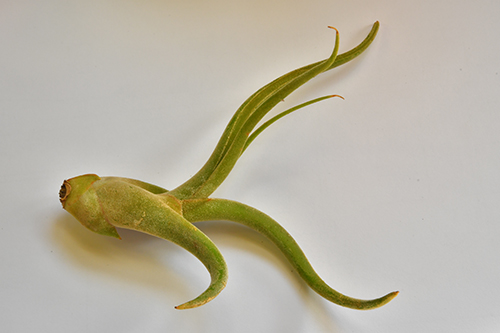
Another curious looking species with a pseudobulb is Tillandsia caput medusa, seen in Picture 7. Aptly named in 1880 by the French botanist Charles Jacques Édouard Morren (1833–1886), the foliage curves about in varied directions, resembling Medusa of Greek mythology whose hair consisted of sinuous snakes! Native to Guatemala, Mexico, Honduras and El Salvador, the abundant trichomes provide an attractive soft silver cast to the serpentine foliage. If you are looking for a much larger form, consider Tillandsia xerographica. The foliage can grow to over 1" wide at the base, tapering to very narrow and curling tips. Leaves are heavily covered with trichomes, giving the swirling foliage a very attractive silver cast. Native to dry forests and scrub areas in Mexico, Guatemala and El Salvador, the plant can grow upwards of 3' in diameter and is best grown in bright light or morning sun, or moved outdoors and fastened to trees during the summer as illustrated at Chanticleer Gardens in Picture 10. The branched flowering inflorescence can grow to several feet tall, with attractive yellow bracts.
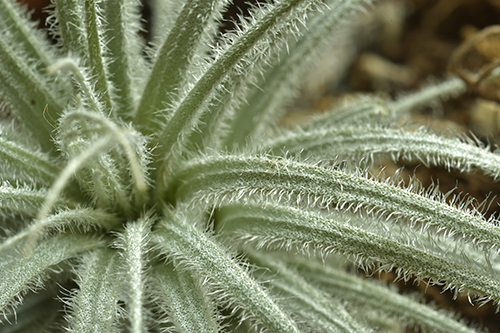
A popular fuzzy appearing species that is more challenging to grow is Tillandsia tectorum. Named in 1877 by Charles Jacques Édouard Morren (1833–1886) a Belgian botanist who was fascinated with Bromeliads, it is native to Ecuador and Peru where the plants grow on cliffs up to 3,500 feet tall and in full sun. It also grows on the roofs of the local Ecuadorian and Peruvian homesteads, which led to the species name meaning 'on roofs'. In response to the harsh conditions, the plants have developed prominent silvery trichomes to reflect the light and keep the plant cooler (Picture 8). These trichomes are in fact the reason this species is a bit harder to grow since they hold the water far too long and can actually interfere with the opening of the stomata at night. As mentioned above, this species is best misted or held under a faucet for 5–10 seconds every two weeks. It has adapted to a very harsh environment and does not appreciate frequent irrigation. In fact this is a plant that is best ignored as it can easily be killed with acts of kindness! It can be kept indoors during the summer months as it seems to appreciate the dryer conditions of air conditioning or place it outdoors in a location where it is protected from abundant ran. I have also found it will perish if grown under a cloche due to the higher humidity. Plants will eventually yield flowers on stems up to 20" long once they have grown to a significant age.
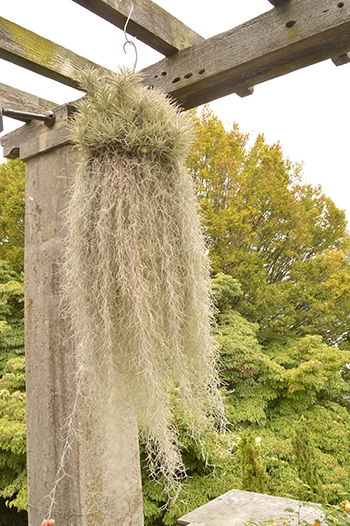
Tillandsia usneoides or Spanish Moss is perhaps the best known and most unique in appearance. Neither from Spain, nor a moss, Carl Linnaeus named the species in 1762 based on how it resembles a lichen named Usnea. Native from Virginia south to Florida and west to Texas and Arkansas, the silvery trailing strands can add an attractive and fun chain-like display, as seen in Picture 9 at Wave Hill. More challenging to grow as a houseplant, it is best to let the plant dry thoroughly between watering, followed by slowly adding cups of water at the top of the 'chain' and to stop once the water begins to drip from the base.
With incredible variation and a very interesting story to tell, specimens of Tillandsia offer unusual houseplants for both the novice and the expert gardener alike. Serious gardeners often mount them to bark strips with wire, giving them a rather natural appearance. As I mentioned at the start, they can be grown in hanging glass spheres, although I personally prefer to place plants into the canopy of other houseplants, such as Jade Plants, Aloe or even larger Bromeliads, where I feel they look most at home during the winter. During the summer they look and grow best when brought outside and placed amongst containers of annuals or tied into trees, like the Tillandsia xerographica in Picture 10 at Chanticleer Gardens. They may not live simply on air, but they do impart a curiosity that draws people to plants—a curiosity leading to a 'trend' that I hope will have a long history among new and experienced gardeners!
